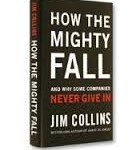 Over the holidays, one of the books I read was “How the mighty fall” by Jim Collins. One of my clients lent me his copy as a must read and I am glad that he did. In fact, I think this ought to be in the reading list of every manager and leader and in every company’s library!
Over the holidays, one of the books I read was “How the mighty fall” by Jim Collins. One of my clients lent me his copy as a must read and I am glad that he did. In fact, I think this ought to be in the reading list of every manager and leader and in every company’s library!
The book is based on his extensive research resulting in a five-stage framework of how companies decline. As someone who has also studied how companies become great, the author declares that, “assembling a data-driven framework of decline proved harder than constructing a data-driven framework of ascent.”
His model consists of five stages, which proceed in sequence. Please note the shortened summary below is pretty much verbatim from this excellent, highly recommended, easy to read book.
STAGE 1: HUBRIS BORN OF SUCCESS.
Great enterprises can become insulated by success; accumulated momentum can carry an enterprise forward, for a while, even if its leaders make poor decisions or lose discipline. Stage 1 kicks in when people become arrogant, regarding success virtually as an entitlement, and they lose sight of the true underlying factors that created success in the first place.
When the rhetoric of success (“We’re successful because we do these specific things”) replaces penetrating understanding and insight (‘We’re successful because we understand why we do these specific things and under what conditions they would no longer work”), decline will very likely follow.
STAGE 2: UNDISCIPLINED PURSUIT OF MORE
Hubris from Stage 1 (“We’re so great, we can do anything!”) leads right into Stage 2, the Undisciplined Pursuit of More – more scale, more growth, more acclaim, more of whatever those in power see as “success.” Companies in Stage 2 stray from the disciplined creativity that led them to greatness in the first place, making undisciplined leaps into areas where they cannot be great or growing faster than they can achieve with excellence, or both. When an organization grows beyond its ability to fill its key seats with the right people, it has set itself up for a fall.
STAGE 3: DENIAL OF RISK AND PERIL
As companies move into Stage 3, internal warning signs begin to mount, yet external results remain strong enough to “explain away” disturbing data or to suggest that the difficulties are “temporary” or “cyclic” or “not that bad” and “nothing fundamentally is wrong.”
In Stage 3, leaders discount negative data, amplify positive data, and put a positive spin on the ambiguous data. Those in power start to blame external factors for setbacks rather than accept responsibility. The vigorous fact-based dialogue that characterizes high-performance teams dwindles or disappears altogether.
STAGE 4: GRASPING FOR SALVATION
The cumulative peril or and/or risks-gone-bad of Stage 3 assert themselves, throwing the enterprise into a sharp decline visible to all. The critical question is, how does its leadership respond? By lurching for a quick salvation or by getting back to the disciplines that brought about greatness in the first place? Those who grasp for salvation have fallen into Stage 4.
Common “saviors” include charismatic visionary leaders, a bold but untested strategy, a radical transformation, a dramatic cultural revolution, a hoped-for blockbuster product, a “game-changing” acquisition or any number of other silver bullet solutions. Initial results from taking dramatic action may appear positive, but they do not last.
STAGE 5: CAPITULATION TO IRRELEVANCE OR DEATH
The longer a company remains in Stage 4, repeatedly grasping for silver bullets, the more likely it will spiral downward. In Stage 5, accumulated setbacks and expensive false starts erode financial strength and individual spirit to such an extent that leaders abandon all hope of building a great future. In some cases, the leaders just sell out; in other cases, the institution atrophies into utter insignificance; and in the most extreme cases, the enterprise simply dies outright.
The book includes great examples of companies such as Merck, HP, Bank of America, Motorola, Zenith, Nordstrom and their various trajectories.
Forewarned is forearmed. A must read!
Jasbindar works as a business psychologist and leadership coach helping senior leaders and their teams stay on the path of success.






 Follow Jasbindar on Twitter
Follow Jasbindar on Twitter



